Voyager 1: Jupiter ahead!
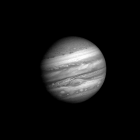 From a distance of 36 million miles, NASA/JPL’s unmanned spacecraft Voyager 1 can already see the planet Jupiter in far greater detail than the cameras aboard Pioneers 10 and 11. Over the next month, Voyager 1 records images as it closes in on its first planetary target, spotting roiling storm clouds and fluid cloud bands with unprecedented clarity; JPL assembles the images into a “movie.” Despite the size of Jupiter at the end of the sequence, Voyager 1 is still over a month away from its closest pass to the giant planet.
From a distance of 36 million miles, NASA/JPL’s unmanned spacecraft Voyager 1 can already see the planet Jupiter in far greater detail than the cameras aboard Pioneers 10 and 11. Over the next month, Voyager 1 records images as it closes in on its first planetary target, spotting roiling storm clouds and fluid cloud bands with unprecedented clarity; JPL assembles the images into a “movie.” Despite the size of Jupiter at the end of the sequence, Voyager 1 is still over a month away from its closest pass to the giant planet.
Voyagers survive the asteroid belt
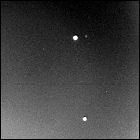 Voyager 1 emerges unharmed from what is considered the outer limit of the asteroid belt between Mars and Jupiter, having entered this 223,000,000-mile-wide zone of space in December 1977. Voyager 2 is expected to emerge similarly unscathed in late October 1978. NASA’s Pioneer 10 and 11 spacecraft had already demonstrated, in the early 1970s, that passage through the asteroid belt without mission-jeopardizing damage is possible. Both spacecraft are already imaging Jupiter from a distance of less than 180,000,000 miles, now meeting or exceeding the resolution of the best photos of Jupiter taken from Earth-based telescopes.
Voyager 1 emerges unharmed from what is considered the outer limit of the asteroid belt between Mars and Jupiter, having entered this 223,000,000-mile-wide zone of space in December 1977. Voyager 2 is expected to emerge similarly unscathed in late October 1978. NASA’s Pioneer 10 and 11 spacecraft had already demonstrated, in the early 1970s, that passage through the asteroid belt without mission-jeopardizing damage is possible. Both spacecraft are already imaging Jupiter from a distance of less than 180,000,000 miles, now meeting or exceeding the resolution of the best photos of Jupiter taken from Earth-based telescopes.
Voyager 2’s mission, should it choose to accept it…
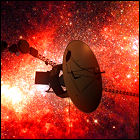 Following a communications blackout scare in April 1978, JPL uploads an autonomous command sequence to the Voyager 2 unmanned space probe, which would allow the spacecraft to carry out a self-guided mission to Jupiter and Saturn, the results of which would automatically be transmitted to Earth even if Voyager 2 can receive no further instructions from Earth. Due to the command storage limitations of Voyager 2’s onboard computer, this automatic backup mission plan makes no allowances for pictures of Jupiter, saving that capability for Saturn instead. In the event that Voyager 2 can no longer hear commands from Earth, the extended mission to Uranus and Neptune would be forfeited in favor of “minimum science return” from Jupiter and Saturn.
Following a communications blackout scare in April 1978, JPL uploads an autonomous command sequence to the Voyager 2 unmanned space probe, which would allow the spacecraft to carry out a self-guided mission to Jupiter and Saturn, the results of which would automatically be transmitted to Earth even if Voyager 2 can receive no further instructions from Earth. Due to the command storage limitations of Voyager 2’s onboard computer, this automatic backup mission plan makes no allowances for pictures of Jupiter, saving that capability for Saturn instead. In the event that Voyager 2 can no longer hear commands from Earth, the extended mission to Uranus and Neptune would be forfeited in favor of “minimum science return” from Jupiter and Saturn.
Voyaging silently onward?
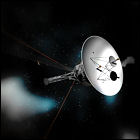 NASA’s Voyager 2 space probe, leaving the inner solar system en route to a grand tour of the outer planets, suddenly stops transmitting to Earth, failing to acknowledge commands sent by its ground controllers. Any chance of the probe conducting its studies of Jupiter and Saturn, let alone Uranus or Neptune, is in serious jeopardy. Discovering a problem with Voyager 2’s ability to compensate for the Doppler shift in signals coming from Earth, NASA engineers devise a workaround to compensate for this problem from the ground, saving the mission.
NASA’s Voyager 2 space probe, leaving the inner solar system en route to a grand tour of the outer planets, suddenly stops transmitting to Earth, failing to acknowledge commands sent by its ground controllers. Any chance of the probe conducting its studies of Jupiter and Saturn, let alone Uranus or Neptune, is in serious jeopardy. Discovering a problem with Voyager 2’s ability to compensate for the Doppler shift in signals coming from Earth, NASA engineers devise a workaround to compensate for this problem from the ground, saving the mission.
Voyaging blindly onward?
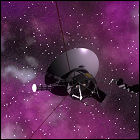 NASA’s Voyager 1 space probe, en route to its first destination, develops a potentially mission-jeopardizing problem: the scan platform, which contains and aims many of Voyager’s scientific instruments, jams and becomes stuck in place. As Voyager 1 has yet to even reach Jupiter, this threatens to make it an expensive failure. Transmitting commands from Earth to give the scan platform a gentle three-axis workout, engineers at NASA manage to free the stuck instruments, salvaging Voyager 1’s mission to the outer planets and their moons. (A similar fault develops in Voyager 2 during its 1981 encounter with Saturn.)
NASA’s Voyager 1 space probe, en route to its first destination, develops a potentially mission-jeopardizing problem: the scan platform, which contains and aims many of Voyager’s scientific instruments, jams and becomes stuck in place. As Voyager 1 has yet to even reach Jupiter, this threatens to make it an expensive failure. Transmitting commands from Earth to give the scan platform a gentle three-axis workout, engineers at NASA manage to free the stuck instruments, salvaging Voyager 1’s mission to the outer planets and their moons. (A similar fault develops in Voyager 2 during its 1981 encounter with Saturn.)
Voyagers depart the inner solar system
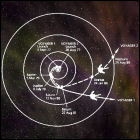 At a distance of nearly 60,000,000 miles from Earth, NASA’s Voyager 1 and Voyager 2 spacecraft cross the orbit of Mars as the twin space probes continue their outbound race toward Jupiter. Moving at 13 miles per second, Voyager 1 will overtake its identical twin, Voyager 2, at the end of 1977, with both spacecraft expected to reach Jupiter in 1979. From here, they will plunge through the asteroid belt between Mars and Jupiter, though fears of damage occurring in this part of space have been allayed by the successful asteroid belt passage of Pioneers 10 and 11 in the early 1970s.
At a distance of nearly 60,000,000 miles from Earth, NASA’s Voyager 1 and Voyager 2 spacecraft cross the orbit of Mars as the twin space probes continue their outbound race toward Jupiter. Moving at 13 miles per second, Voyager 1 will overtake its identical twin, Voyager 2, at the end of 1977, with both spacecraft expected to reach Jupiter in 1979. From here, they will plunge through the asteroid belt between Mars and Jupiter, though fears of damage occurring in this part of space have been allayed by the successful asteroid belt passage of Pioneers 10 and 11 in the early 1970s.
No comet for Voyagers
 NASA announces that Voyagers 1 and 2 may be in a unique position to study the newly-discovered Comet Kohler 1977 XIV, discovered just days before Voyager 1’s launch. Both Voyagers are expected to pass Comet Kohler at a distance of a little over 1 astronomical unit (AU), equivalent to the distance between Earth and the Sun, in November, and the possibility of examining the comet with their onboard instruments is proposed. This plan is eventually abandoned, since the comet will track near the sun, direct exposure to which could harm the television tube cameras installed aboard each Voyager. The exploration of comets with robotic spacecraft will have to wait until the 1980s.
NASA announces that Voyagers 1 and 2 may be in a unique position to study the newly-discovered Comet Kohler 1977 XIV, discovered just days before Voyager 1’s launch. Both Voyagers are expected to pass Comet Kohler at a distance of a little over 1 astronomical unit (AU), equivalent to the distance between Earth and the Sun, in November, and the possibility of examining the comet with their onboard instruments is proposed. This plan is eventually abandoned, since the comet will track near the sun, direct exposure to which could harm the television tube cameras installed aboard each Voyager. The exploration of comets with robotic spacecraft will have to wait until the 1980s.
Voyager 1 photographs its first planet
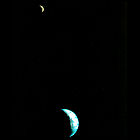 Barely two weeks after launch, Voyager 1 captures the first-ever photo of the Earth and its moon in their entirety, from a distance of just over seven million miles. Due to the moon’s relatively low visibility, JPL has to “brighten” the moon so it’s visible in the photo. Voyager 1 soon loses sight of Earth and the moon as it speeds toward Jupiter, a planet it won’t reach until 1979.
Barely two weeks after launch, Voyager 1 captures the first-ever photo of the Earth and its moon in their entirety, from a distance of just over seven million miles. Due to the moon’s relatively low visibility, JPL has to “brighten” the moon so it’s visible in the photo. Voyager 1 soon loses sight of Earth and the moon as it speeds toward Jupiter, a planet it won’t reach until 1979.
There’s still no word on whether or not Voyager 1 found signs of intelligent life on Earth.
Voyager 1 leaves Earth
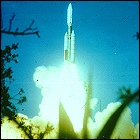 The unmanned robotic Voyager 1 space probe lifts off on a voyage to Jupiter, Saturn and beyond, taking advantage of a once-in-175-years alignment of the planets in the outer solar system. Originally designated Mariner 11, one of many planned space probes in the now greatly scaled-back Mariner Jupiter/Saturn ’77 program, Voyager 1 is also the first spacecraft to take a picture of the Earth and its moon from beyond the moon’s orbit, and will become the first human-made object to leave Earth’s solar system.
The unmanned robotic Voyager 1 space probe lifts off on a voyage to Jupiter, Saturn and beyond, taking advantage of a once-in-175-years alignment of the planets in the outer solar system. Originally designated Mariner 11, one of many planned space probes in the now greatly scaled-back Mariner Jupiter/Saturn ’77 program, Voyager 1 is also the first spacecraft to take a picture of the Earth and its moon from beyond the moon’s orbit, and will become the first human-made object to leave Earth’s solar system.
Voyager 2 launches
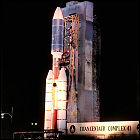 NASA launches Voyager 2 (weeks ahead of Voyager 1), giving the unmanned space probe the best shot of taking advantage of a favorable planetary alignment known as the “Grand Tour”. Using a series of carefully calculated gravity assists, Voyager has the potential to visit all four of the major outer gas planets – Jupiter, Saturn, Uranus and Neptune – in under 15 years without having to expend fuel to make the trip. If Voyager 2 survives long enough to visit Uranus or Neptune, it will become the first man-made spacecraft to visit either planet.
NASA launches Voyager 2 (weeks ahead of Voyager 1), giving the unmanned space probe the best shot of taking advantage of a favorable planetary alignment known as the “Grand Tour”. Using a series of carefully calculated gravity assists, Voyager has the potential to visit all four of the major outer gas planets – Jupiter, Saturn, Uranus and Neptune – in under 15 years without having to expend fuel to make the trip. If Voyager 2 survives long enough to visit Uranus or Neptune, it will become the first man-made spacecraft to visit either planet.
Voyager switcheroo
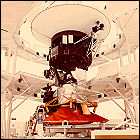 Mere weeks before the launch of the first Voyager spacecraft, NASA swaps Voyager 2 and Voyager 1. Repeated failures have plagued the attitude and articulation control and flight data subsystems in the spacecraft designated VGR77-2, leaving mission planners with doubt about its flightworthiness. VGR77-3 thus becomes Voyager 2, and VGR77-2 undergoes repairs to correct its problems before being designated Voyager 1. The two vehicles’ thermonuclear power sources are swapped, as whichever one is Voyager 2 will require a longer-lasting power source to power all instruments for possible visits to Uranus and Neptune following the 1981 Saturn encounter. (A third vehicle, VGR77-1, is an engineering test spare which eventually goes on display at the JPL campus in Pasadena.)
Mere weeks before the launch of the first Voyager spacecraft, NASA swaps Voyager 2 and Voyager 1. Repeated failures have plagued the attitude and articulation control and flight data subsystems in the spacecraft designated VGR77-2, leaving mission planners with doubt about its flightworthiness. VGR77-3 thus becomes Voyager 2, and VGR77-2 undergoes repairs to correct its problems before being designated Voyager 1. The two vehicles’ thermonuclear power sources are swapped, as whichever one is Voyager 2 will require a longer-lasting power source to power all instruments for possible visits to Uranus and Neptune following the 1981 Saturn encounter. (A third vehicle, VGR77-1, is an engineering test spare which eventually goes on display at the JPL campus in Pasadena.)
The Golden Record
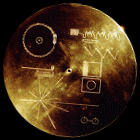 With less than a month to go before the launch of the first of two Voyager unmanned spacecraft, NASA attaches copper phonograph records, encased in lightweight, protective golden casings, to each of the Voyager probes. With participation from Carl Sagan (who led the effort to mount a plaque on the Pioneer probes consisting only of visual information), SETI pioneer Frank Drake, Jon Lomberg and others, the 12″ LP consists of not only sound recordings, but photos and diagrams depicting the diversity and composition of life on Earth. The sounds include various kinds of Earth wildlife, spoken messages from President Jimmy Carter and United Nations Secretary-General Kurt Waldheim, music from Beethoven and Bach to Chuck Berry (the Beatles decline permission to include “Here Comes The Sun”), and Carl Sagan’s young son Nick delcaring “Greetings from the children of planet Earth.” The outer casing includes a playback mechanism and diagrams for how to use it.
With less than a month to go before the launch of the first of two Voyager unmanned spacecraft, NASA attaches copper phonograph records, encased in lightweight, protective golden casings, to each of the Voyager probes. With participation from Carl Sagan (who led the effort to mount a plaque on the Pioneer probes consisting only of visual information), SETI pioneer Frank Drake, Jon Lomberg and others, the 12″ LP consists of not only sound recordings, but photos and diagrams depicting the diversity and composition of life on Earth. The sounds include various kinds of Earth wildlife, spoken messages from President Jimmy Carter and United Nations Secretary-General Kurt Waldheim, music from Beethoven and Bach to Chuck Berry (the Beatles decline permission to include “Here Comes The Sun”), and Carl Sagan’s young son Nick delcaring “Greetings from the children of planet Earth.” The outer casing includes a playback mechanism and diagrams for how to use it.
In the decades to come, fictional aliens visiting or invading Earth because they have viewed the Voyager “Golden Record” becomes a staple of science fiction media.
The Rings of Uranus
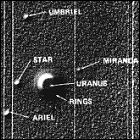 A team of MIT astronomers, flying in a plane modified to serve as an airborne high-altitude telescope, plans to observe the planet Uranus as it eclipses, or “occults”, a star. But the team observes more occultations than expected both before and after the planet itself passes in front of the star. The inevitable conclusion is that Uranus has rings, made of material too dark to be detected by existing Earthbound telescopes. Further observations are given top priority: NASA’s Voyager 2 space probe, due to lift off later in 1977, may last long enough to reach Uranus, and the newly discovered rings must be taken into account when planning its flyby trajectory.
A team of MIT astronomers, flying in a plane modified to serve as an airborne high-altitude telescope, plans to observe the planet Uranus as it eclipses, or “occults”, a star. But the team observes more occultations than expected both before and after the planet itself passes in front of the star. The inevitable conclusion is that Uranus has rings, made of material too dark to be detected by existing Earthbound telescopes. Further observations are given top priority: NASA’s Voyager 2 space probe, due to lift off later in 1977, may last long enough to reach Uranus, and the newly discovered rings must be taken into account when planning its flyby trajectory.
Now, Voyager
 NASA Administrator James Fletcher announces that the ambitious twin Mariner Jupiter/Saturn ’77 space probes, due to be launched later in the year, have been christened with new names: Voyager 1 and Voyager 2. The name change has been initiated by recently-promoted Voyager program manager John Casani, who thinks the spacecraft need a name that’s less of a mouthful (the name “Discoverer” was also considered). For the first time, NASA openly admits that one of the vehicles – Voyager 2 – may continue on to Uranus and Neptune should its Saturn flyby go well in 1981, depending on the spacecraft’s health.
NASA Administrator James Fletcher announces that the ambitious twin Mariner Jupiter/Saturn ’77 space probes, due to be launched later in the year, have been christened with new names: Voyager 1 and Voyager 2. The name change has been initiated by recently-promoted Voyager program manager John Casani, who thinks the spacecraft need a name that’s less of a mouthful (the name “Discoverer” was also considered). For the first time, NASA openly admits that one of the vehicles – Voyager 2 – may continue on to Uranus and Neptune should its Saturn flyby go well in 1981, depending on the spacecraft’s health.
The Uranus Option
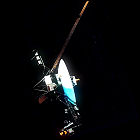 Despite the fact that a useful – and rare – alignment of the large outer planets will make a “Grand Tour” possible, NASA has only thus far funded a stripped-down version of the ambitious original Grand Tour plan, a pair of Mariner Jupiter/Saturn ’77 unmanned space probes (later renamed Voyager). Jet Propulsion Laboratory admits that scientists and mission planners have drawn up a “Uranus option” to extend the mission of one of the vehicles to reach Uranus four or five years after a Saturn encounter and gravity assist, and are making modifications to one of the vehicles to permit this contingency. (NASA has yet to approve continuing the MJS’77 program long enough to reach Uranus.) Mission planners also admit that a visit to Uranus could give the vehicle another gravity assist toward Neptune, while admitting that the odds of the vehicle surviving a journey to Neptune with its ability to gather images and scientific data intact would require “a miracle.”
Despite the fact that a useful – and rare – alignment of the large outer planets will make a “Grand Tour” possible, NASA has only thus far funded a stripped-down version of the ambitious original Grand Tour plan, a pair of Mariner Jupiter/Saturn ’77 unmanned space probes (later renamed Voyager). Jet Propulsion Laboratory admits that scientists and mission planners have drawn up a “Uranus option” to extend the mission of one of the vehicles to reach Uranus four or five years after a Saturn encounter and gravity assist, and are making modifications to one of the vehicles to permit this contingency. (NASA has yet to approve continuing the MJS’77 program long enough to reach Uranus.) Mission planners also admit that a visit to Uranus could give the vehicle another gravity assist toward Neptune, while admitting that the odds of the vehicle surviving a journey to Neptune with its ability to gather images and scientific data intact would require “a miracle.”
Titan IIIe
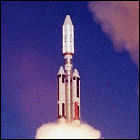 In advance of the Viking and Voyager interplanetary missions, which will need more powerful boosters to heft heavier spacecraft into deep space, NASA conducts a test launch of the Titan IIIe/Centaur launch stack, an experimental combination of the venerable Titan rocket and a liquid-fueled Centaur upper stage. Previous Centaur upper stages were attached to wider Atlas rockets, so the unusual bulb-shaped payload shroud of the Centaur is of concern when placed atop the Titan, which has a more narrow diameter; if successful, however, this configuration could launch payloads three times larger than an Atlas/Centaur combination. The test flight, originally scheduled for January 24th, actually fails – a loose part causes the Centaur stage to fizzle rather than fire – and the rocket is destroyed in mid-air. However, with worries about the large Centaur payload atop the narrow Titan rocket laid to rest, NASA approves the Titan IIIe/Centaur for flight, beginning with the launch of a joint American/German science satellite, HELIOS-1, later in 1974.
In advance of the Viking and Voyager interplanetary missions, which will need more powerful boosters to heft heavier spacecraft into deep space, NASA conducts a test launch of the Titan IIIe/Centaur launch stack, an experimental combination of the venerable Titan rocket and a liquid-fueled Centaur upper stage. Previous Centaur upper stages were attached to wider Atlas rockets, so the unusual bulb-shaped payload shroud of the Centaur is of concern when placed atop the Titan, which has a more narrow diameter; if successful, however, this configuration could launch payloads three times larger than an Atlas/Centaur combination. The test flight, originally scheduled for January 24th, actually fails – a loose part causes the Centaur stage to fizzle rather than fire – and the rocket is destroyed in mid-air. However, with worries about the large Centaur payload atop the narrow Titan rocket laid to rest, NASA approves the Titan IIIe/Centaur for flight, beginning with the launch of a joint American/German science satellite, HELIOS-1, later in 1974.
Mariner Jupiter/Saturn ’77
 Having spent six years wrangling with various mission profiles for a “Grand Tour” of the outer solar system, made possible by a favorable planetary alignment occurring only once every 175 years, NASA finally authorizes a very stripped-down version of its original ambitious Grand Tour plans. The Mariner Jupiter/Saturn ’77 mission will consist of two twin unmanned spacecraft to be launched in 1977, each on a course to explore Jupiter, and then to use Jupiter’s gravity to deflect them to Saturn. These spacecraft will be renamed Voyager 1 and Voyager 2 just a few months before lifting off.
Having spent six years wrangling with various mission profiles for a “Grand Tour” of the outer solar system, made possible by a favorable planetary alignment occurring only once every 175 years, NASA finally authorizes a very stripped-down version of its original ambitious Grand Tour plans. The Mariner Jupiter/Saturn ’77 mission will consist of two twin unmanned spacecraft to be launched in 1977, each on a course to explore Jupiter, and then to use Jupiter’s gravity to deflect them to Saturn. These spacecraft will be renamed Voyager 1 and Voyager 2 just a few months before lifting off.
Voyager mission cancelled
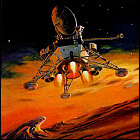 After data returned by JPL’s Mariner spacecraft reveals that – as JPL predicted – Mars has a thin atmosphere and very low atmospheric pressure, plans for a Saturn V-launched orbiter with two 10,000-pound Mars landers are scuttled. The Voyager Mars mission, not expected to launch until 1973, proved too complex and costly for the current state of the art. The Voyager name will later be bestowed upon a pair of Mariner spacecraft exploring beyond the orbit of Mars, while the Voyager concept will later be scaled down to a more feasible and cost-effective orbiter/lander combination called Viking.
After data returned by JPL’s Mariner spacecraft reveals that – as JPL predicted – Mars has a thin atmosphere and very low atmospheric pressure, plans for a Saturn V-launched orbiter with two 10,000-pound Mars landers are scuttled. The Voyager Mars mission, not expected to launch until 1973, proved too complex and costly for the current state of the art. The Voyager name will later be bestowed upon a pair of Mariner spacecraft exploring beyond the orbit of Mars, while the Voyager concept will later be scaled down to a more feasible and cost-effective orbiter/lander combination called Viking.
The Grand Tour
 The Grand Tour Outer Planets mission is proposed to NASA by the Jet Propulsion Laboratory. Using a combination of the gravitational assist trajectories computed by JPL’s Michael Minovitch in 1961, Caltech/JPL grad student Gary Flandro has identified a favorable alignment of the outer planets which would allow for a single spacecraft to reach Jupiter, Saturn, Uranus, Neptune and Pluto within two decades. Vehicles taking advantage of this planetary alignment must lift off at very precise times during 1977 and 1978, and the alignment will not occur again for nearly 200 years. An ambitious plan is laid out for multiple flyby vehicles with atmospheric probes for every gas planet and landers for specific moons of interest, launched by Saturn V rockets. Budget realities scale this plan back: flybys will be carried out by two cheaper Mariner vehicles (later renamed Voyager), while the atmospheric and satellite probes – eventually to be renamed Galileo and Cassini – wait even longer to reach their destinations, and the Pluto flyby is scrapped until the 21st century New Horizons probe lifts off. JPL also recommends an inner solar system tryout of the gravitational assist maneuvers required, resulting in the Mariner 10 mission to Venus and Mercury.
The Grand Tour Outer Planets mission is proposed to NASA by the Jet Propulsion Laboratory. Using a combination of the gravitational assist trajectories computed by JPL’s Michael Minovitch in 1961, Caltech/JPL grad student Gary Flandro has identified a favorable alignment of the outer planets which would allow for a single spacecraft to reach Jupiter, Saturn, Uranus, Neptune and Pluto within two decades. Vehicles taking advantage of this planetary alignment must lift off at very precise times during 1977 and 1978, and the alignment will not occur again for nearly 200 years. An ambitious plan is laid out for multiple flyby vehicles with atmospheric probes for every gas planet and landers for specific moons of interest, launched by Saturn V rockets. Budget realities scale this plan back: flybys will be carried out by two cheaper Mariner vehicles (later renamed Voyager), while the atmospheric and satellite probes – eventually to be renamed Galileo and Cassini – wait even longer to reach their destinations, and the Pluto flyby is scrapped until the 21st century New Horizons probe lifts off. JPL also recommends an inner solar system tryout of the gravitational assist maneuvers required, resulting in the Mariner 10 mission to Venus and Mercury.
Voyager… to Mars!
 Following up on preliminary studies assuming almost-Earthlike conditions, NASA commences work on a major robotic interplanetary landing mission called Voyager, which will use a Saturn IB rocket to send an orbiter with two landers to Mars. But NASA is doing so without much help from its usual interplanetary think-tank, Jet Propulsion Laboratory, whose scientists warn NASA that the latest astronomical data suggests a significantly thinner atmosphere and lower atmospheric pressure than the scenario for which NASA is designing its vehicles. As the complexity involved in creating self-guided landers with on-board laboratories increases, contractors begin to insist that only a Saturn V will do; since all Saturn V boosters are currently in reserve for Apollo lunar missions, NASA pushes the Voyager mission back into the 1970s.
Following up on preliminary studies assuming almost-Earthlike conditions, NASA commences work on a major robotic interplanetary landing mission called Voyager, which will use a Saturn IB rocket to send an orbiter with two landers to Mars. But NASA is doing so without much help from its usual interplanetary think-tank, Jet Propulsion Laboratory, whose scientists warn NASA that the latest astronomical data suggests a significantly thinner atmosphere and lower atmospheric pressure than the scenario for which NASA is designing its vehicles. As the complexity involved in creating self-guided landers with on-board laboratories increases, contractors begin to insist that only a Saturn V will do; since all Saturn V boosters are currently in reserve for Apollo lunar missions, NASA pushes the Voyager mission back into the 1970s.
Gravitational assist
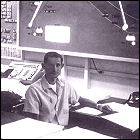 Recent Jet Propulsion Laboratory hire Michael Minovitch submits the first of a series of papers and technical memorandums on the possibility of using carefully-calculated gravitational assist maneuvers to speed transit time between celestial bodies while requiring minimal engine/fuel use. Where most previous scientific thought concentrated on using engine burns (and a lot of fuel) to cancel the effects of a planet’s gravity, Minovitch demonstrated that gravity could be a big help with a carefully calculated trajectory. Though nearly every planetary mission since then has capitalized on Minovitch’s research, it was initially rejected by JPL. Minovitch’s calculations are later revisited by Caltech grad student Gary Flandro, who flags down a particular combination of Minovitch’s pre-computed trajectories for a “grand tour” of the outer solar system, a mission which will eventually be known – in a somewhat scaled-down, less grand form – as Voyager.
Recent Jet Propulsion Laboratory hire Michael Minovitch submits the first of a series of papers and technical memorandums on the possibility of using carefully-calculated gravitational assist maneuvers to speed transit time between celestial bodies while requiring minimal engine/fuel use. Where most previous scientific thought concentrated on using engine burns (and a lot of fuel) to cancel the effects of a planet’s gravity, Minovitch demonstrated that gravity could be a big help with a carefully calculated trajectory. Though nearly every planetary mission since then has capitalized on Minovitch’s research, it was initially rejected by JPL. Minovitch’s calculations are later revisited by Caltech grad student Gary Flandro, who flags down a particular combination of Minovitch’s pre-computed trajectories for a “grand tour” of the outer solar system, a mission which will eventually be known – in a somewhat scaled-down, less grand form – as Voyager.